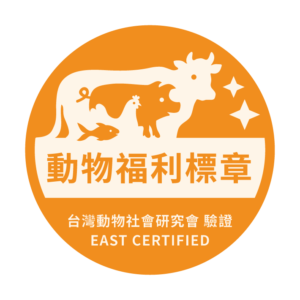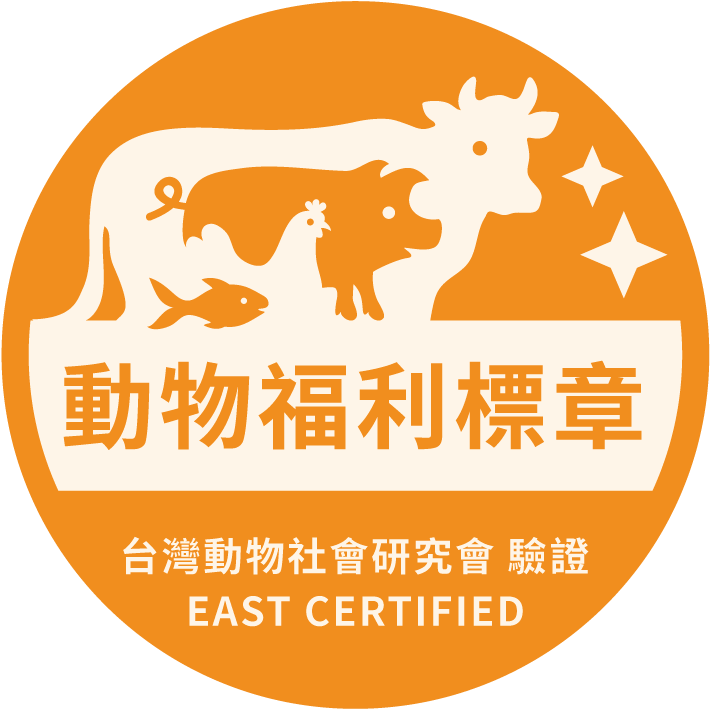
EAST Certified
Animal Welfare Certification
Giving animals a better life
Taiwan’s First Animal Welfare Certification Mark
Each time you make the choice to purchase a certified product you are helping to give animals a better life. Animal health and welfare are intimately connected, so better animal welfare means peace of mind for you and the people you care about.
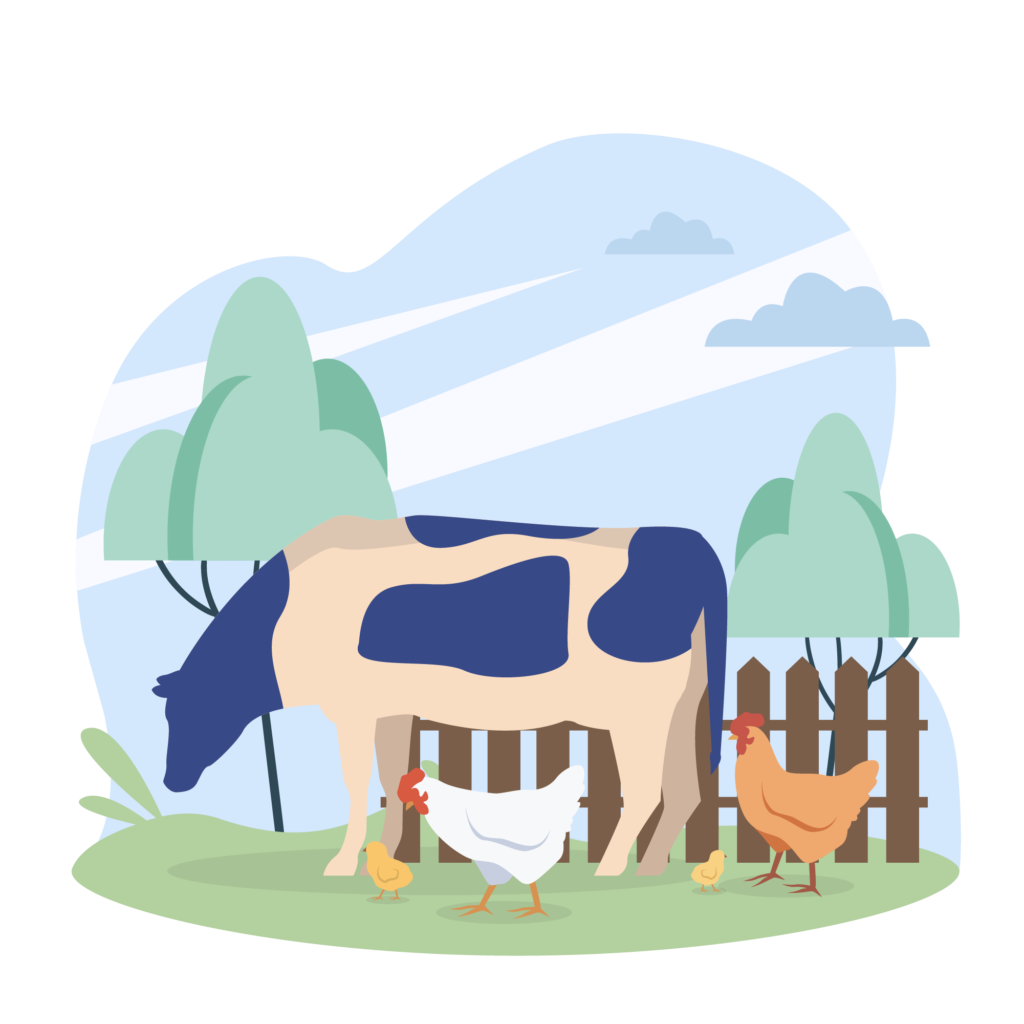
A Better Life For Animals
Every time you choose EAST Certified products you are sending a message of support to farmers that take better care of their farmed animals. Together, we can start a cycle of kindness and build a better world for animals.
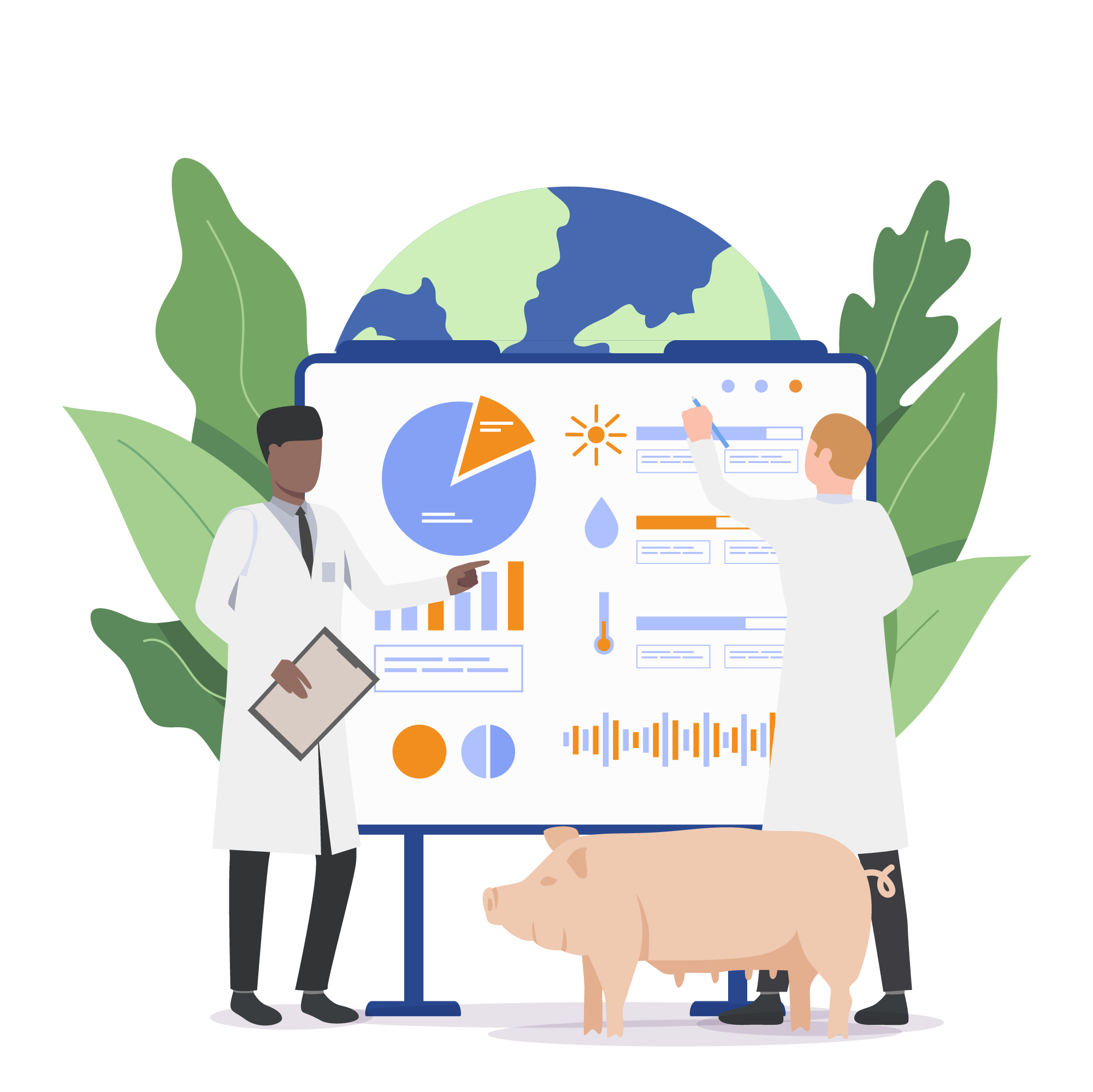
Comprehensive Evidence-Based Standards
The animal welfare standards used by EAST Certified are based on international examples and localized with reference to Taiwanese industry conditions. The standards are revised regularly in line with the latest scientific research. This ensures that farms are continuously improving.

Led by a Reputable Animal Protection Non-Profit
EAST consults with local and international experts, industry operators, farmers and government representatives to develop impartial certification standards and strict auditing procedures.
The story behind the mark
Why EAST Certified?
Impacting Countless Animals
Taiwan raises hundreds of millions of farmed animals each year to produce meat, eggs and dairy products – but only a tiny proportion of these animals are raised on farms that meet their welfare needs.
Living in Pain and Fear
Spurring Industry Change
為改善龐大經濟動物的處境,我們號召願意善待動物的農民,驗證具動物福利的牧場,帶動台灣畜牧業轉型為友善畜牧。
Empowering Consumers
Every time you open your wallet, you are casting a vote for how animals are treated. You can give animals a better life and safeguard your health by supporting products with the EAST Certified mark.
What is animal welfare?
Industrial agriculture views animals as profit-making commodities instead of living creatures with individual lives and interests. Animals are sentient beings able to feel pain and joy, and each animal has their own physical, environmental, behavioral, psychological, and social needs. The Five Freedoms established in the 1960s describe the freedoms to fulfil these needs.動物福利五大自由。
Zoonotic diseases outbreaks like the COVID-19 pandemic, growing antibiotic resistance, food safety crises and other issues show that animal welfare is critical for both humans and animals.
Freedom from hunger and thirst
Freedom from fear and distress
Freedom from physical discomfort
Freedom from pain, injury and disease
Freedom to express normal behavior
What the mark means
A better life for animals
Standards for Dairy Cattle

努力緩解台灣乳牛困境💪
These 11 indicators mean a better life for dairy cattle in Taiwan
Living Environment and Space
Dairy cattle establish complex social relationships and create hierarchies according to age, body size, and body weight. Cattle also lick each other to demonstrate their bonds and affiliation with the herd.
When space and food resources are sufficient, cattle can live in a herd peacefully without competition. Each animal must have at least eight square meters of space to ensure they can find a comfortable space of their own.
The barn must be kept dry to avoid slips and provide ample space to navigate, allowing the animals to move freely without impediment. In addition, when pasture grazing is not possible, providing nourishment (for example, salt bricks), toys (for example, cattle brushes) or space for the animals to play and exercise are the secrets to a happier life.
Food and Water
Can you imagine being crammed together with a group of people and needing to fight over food? Ensuring that all cattle have enough space to eat without disturbance and clean, unlimited drinking water is a must for dairy farms, and a fundamental animal welfare requirement.
Each animal must have a minimum of 75 centimeters of feeding space, in addition to at least one meter of drinking space for every 20 cattle.
Relief From Heat Stress
The black and white dairy cattle you are familiar with, known as Holstein cattle, hail from temperate European climates. They are most comfortable in temperatures of 4.5-15°C. When temperatures exceed 22°C in humid conditions the cattle are at risk of feeling unwell and suffering heat stress. When this occurs the animals will continuously pant, drool, and experience reduced appetite, resulting in malnourishment and eventually illness.
A well-managed farm that adheres to animal welfare standards should monitor the temperature and humidity of the barn where cattle are kept and use cooling systems (such as fans, water mist sprays, sunshades, etc.) to ensure that dairy cattle living in Taiwan’s subtropical climate are protected from heat stress.
A Comfortable Space to Lie Down
Mother cows – weighing up to 700 kilograms – need to consume large amounts of energy every day to produce milk. They need to lie down for an average of about 14 hours a day to relax their limbs and increase blood circulation to the breasts.
Dairy cattle love to be clean. They don't like lying in their excrement and need soft, comfortable resting places, such as grass. Farms that care about animal welfare will provide each animal with soft, clean bedding so that the animals do not have to sleep on hard floors or manure piles. There must be more cow beds than cattle so that each animal can choose where to rest according to the hierarchy of the herd, social relationships and other factors.
Cow beds can also protect joints from injury as a result of excessive friction.
Cattle Management and Care Records
Dairy cattle management is a complicated science. Keepers should monitor and record the animals’ details from birth through to puberty, and from pregnancy to childbirth. Records of medical treatment, feed allocations, disease prevention measures, establishment of SOPs and other records all offer important proof that the cattle have been properly cared for.
Disease Prevention and Treatment
The three most common diseases experienced by dairy cattle are hoof disease, mastitis, and reproductive and metabolic diseases.
Hoof disease: Hooves bear the weight of the animal. If they are not trimmed regularly they are prone to inflammation and infection. This can cause foot pain and difficulty walking. Farms must ensure hooves are trimmed regularly, keep the barn dry, and give immediate treatment to cattle that have already developed hoof disease. To reduce the risk of hoof injury, flooring materials must not be too hard or slippery and pathways shouldn’t have any sharp U-turns.
Mastitis: Dairy cattle have four udders. The teats of the udder remain open after milking, and without proper care they are vulnerable to bacterial infection. This can lead to inflammation of the udder, causing pain and fever. Hygienic milking procedures and gentle milkers are essential for cattle to be milked in safety and peace.
Reproductive and metabolic diseases: Dairy cattle are usually kept in a state of simultaneous lactation and pregnancy, requiring the body to release large amounts of nutrients. The appetite of mother cattle can be substantially affected as the fetus grows and presses on her internal organs. This requires professional nutritional care.
Breeding and Management of Pregnant Cattle
Like humans, it is possible to predict when cattle are due to give birth. Expecting cattle should be moved to sanitary delivery rooms in advance so that they can give birth safely and without disturbance.
In normal circumstances, cattle can give birth naturally and farmers should not intervene unless the animal is having difficulties. Human intervention during childbirth may cause unnecessary harm to the mother.
The delivery room must provide at least 11.9 square meters of space per animal.
Calf Management
New-born calves have extremely weak immune systems. The antibodies contained in the mother cow’s colostrum are the panacea for the calf needs to fight against disease. Calves need to drink good quality colostrum within 4 to 6 hours after birth to replenish antibodies and boost immunity.
Calves are able to stand and move about within a few minutes after birth, but they often fall down. Therefore, the calf stalls must provide at least 1.8 square meters of space and be padded to protect the calves from injuring themselves.
Calves are usually segregated without their mother's company or breastmilk. This can deprive them of a sense of security and mean they are unable to fulfill their desire to suck their mothers’ teats. Therefore, farms must provide toys for exploration and sucking.
Small horns will appear on the calves' heads at about one week of age. Calves are typically dehorned to prevent fighting and injury. Dehorning should be carried out using anesthesia and pain relief to reduce pain for the animal.
Treatment of Sick and Injured Cattle
If an animal is found to be sick or injured they should be carefully moved to a special treatment area. This is to ensure that the animal has access to medical assistance and can fully recuperate. The animal should never be left to fend for itself.
Professionalism of Keepers
Keepers responsible for dairy cattle must engage in training to improve their professional knowledge. Even more importantly, they must empathize with the difficulties of milk production, be aware of animal welfare issues that can arise in farm environments, and treat cattle with the appropriate attitude and expertise. Keepers must also be able to judge the health, behaviour, and stress levels of cattle, and must not engage in any kind of abusive behavior.
Biosecurity Measures
Farms raise large numbers of animals and must implement rigorous disease prevention plans to avoid the import of external pathogens and the spread of disease. These plans should include vaccination, procedures to repel mosquitos, procedures to prevent contamination from visiting persons or vehicles, and regular disinfection.
Living Environment and Space
Food and Water
Relief From Heat Stress
A Comfortable Space to Lie Down
Cattle Management and Care Records
Disease Prevention and Treatment
Breeding and Management of Pregnant Cattle
Calf Management
Treatment of Sick and Injured Cattle
Professionalism of Keepers
Biosecurity Measures
Standards for Laying Hens
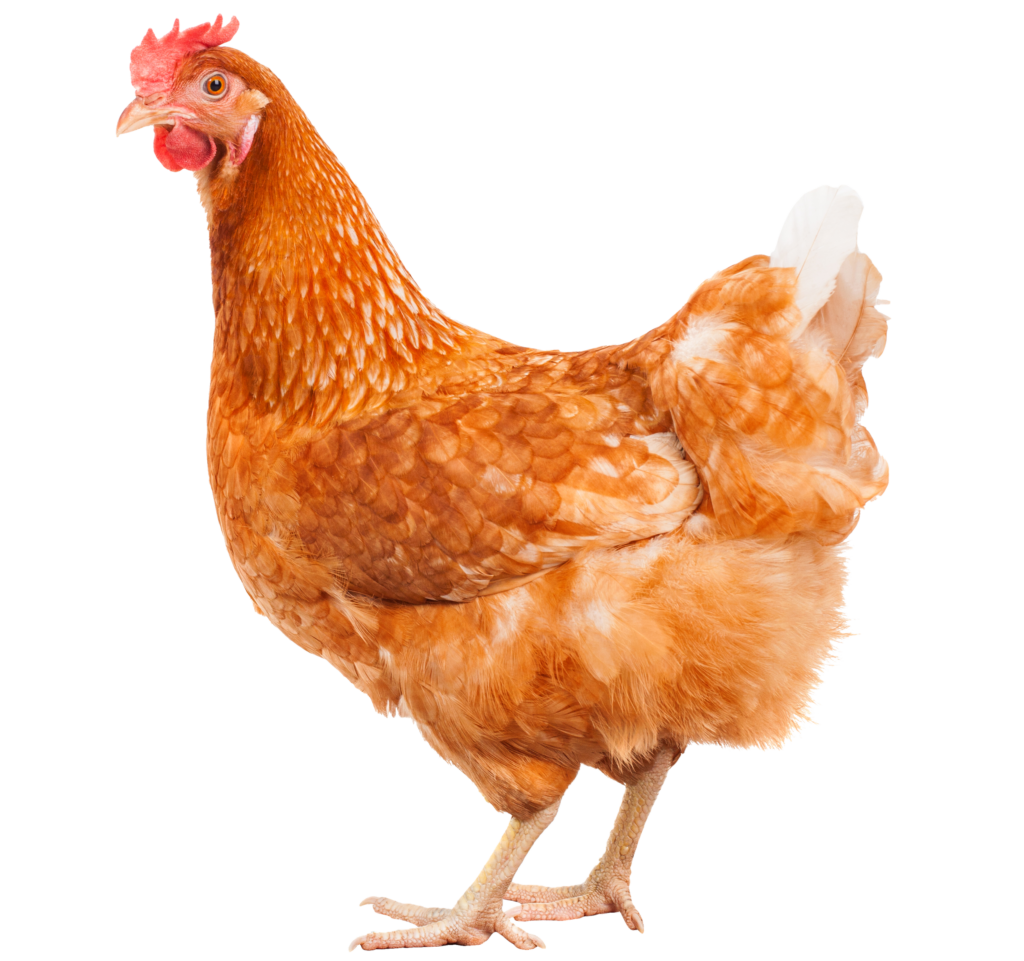
Healthy hens, healthy eggs 
The five principles for better hen welfare. Out with the bad eggs, in with the good eggs!
Cage-Free Farming
Countless scientific studies have shown that only barn and free range housing systems are able to meet hens’ animal welfare needs. In barn systems, hens live in indoor hen houses. In free range systems, hens have access to indoor hen houses in addition to an outdoor range. These two systems both allow hens to move around freely.
Hens on farms are constantly surrounded by other hens. In such environments, bullying can occur. Farms should raise a maximum of nine hens per square meter, allowing hens that don’t get along with each other to keep their distance.
Nesting Instincts
Hens are at their most vulnerable during laying. Hens have an innate desire and need to nest, regardless of what environment they are kept in. Laying eggs is an energy-draining process. Hens treasure their eggs whether they are fertilized or not, and will always try to find a clean, private place to lay their eggs in.
It is important for farms to provide nest boxes where hens can lay their eggs at ease.
Foraging and Dustbathing
Hens are curious by nature. Wild chickens spend more than half of their lives pecking and foraging. Farms should provide litter and toys to meet these needs and give the hens a richer life.
Hens also need litter or sand to dustbathe. Hens will dig a hole to lie in, sprinkle dust over their feathers and skin, then shake off the dust to remove any pests or unwanted matter. Dustbathing is an important process for hens to maintain their health, without the need for fipronil or other insecticides.
A Safe Place to Perch
In the wild, hens are prey animals so they like to perch in high places with a good view of their surroundings to feel safe. Hens need at least 15 centimeters of perch space to get a good night’s sleep.
為了讓每隻雞都有自己休息的地方,應提供每隻雞至少15公分的棲桿,讓母雞能一夜好眠~
Professional Management
When a flock’s egg production declines, most caged farms will cut off food and water supplies to induce forced moulting. This causes hens to enter their final egg-laying cycle, draining them of every last ounce of energy.
Farms with EAST Certified certification respect hens’ natural instincts and are not permitted to conduct forced moulting. Certified farms provide professional care and record and monitor the health of their flock on a daily basis.
Cage-Free Farming
Nesting Instincts
Foraging and Dustbathing
A Safe Place to Perch
Professional Management
【 豬隻篇 】
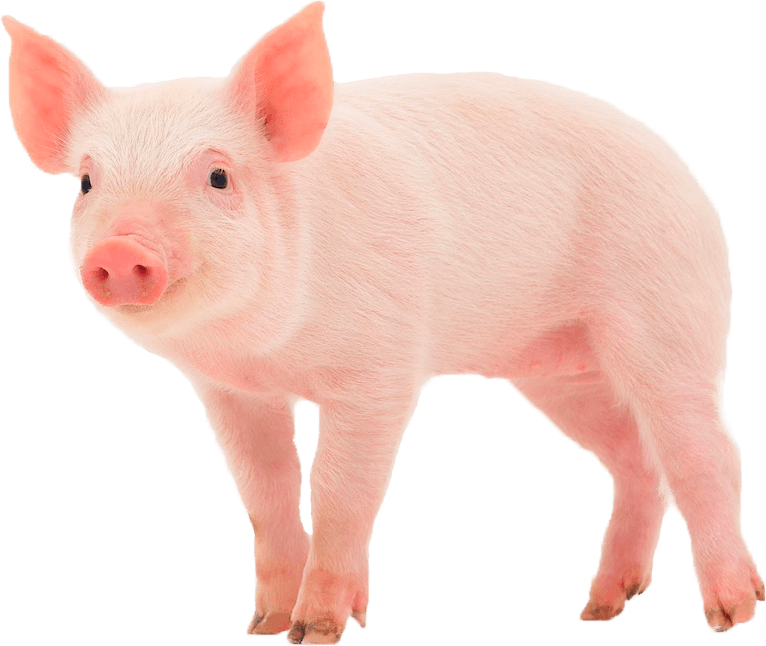
改善台灣豬隻動物福利 🙌
7 項重要指標,提升豬隻動物福利
銷售方式不得透過「活體拍賣」
台灣目前仍有八成五以上的豬隻在屠宰前,必須經歷一連串運輸、暴力驅趕與走秀等活體拍賣過程,包含被禁食禁水、時常不當且暴力的驅趕、繫留過程無法好好休息、最後還要在驚恐的狀態下「走秀」讓承銷人競價標購,飽受痛苦折磨。
活體拍賣不僅嚴重傷害動物福利,也影響肉品品質與食品安全。為改善台灣豬隻處境,欲取得本標章的產品必須直送屠宰場,免於豬隻遭受拍賣銷售過程的不當對待與恐懼緊迫。
飼料及水
豬是高度聰明、好奇、適應性強的社會性動物,在許多學習測試中,牠們的學習力勝過狗。在豬欄有限的空間裡,必須提供足夠的採食飲水空間,才能避免豬隻爭搶食物、水源,或是發生較弱勢的豬吃到一半被驅趕的情況。
豬喜歡在進食後喝水,太髒的水牠們會拒喝,因此提供符合豬隻營養所需飼料及水源的品質也非常重要,必須定期檢驗,保持用餐環境與器具乾淨,更不能因管理不當影響到動物充足且定時的飲食。
畜舍環境空間
豬喜歡生活在穩定的社群或熟悉的小群體(約6隻)中,他們有豐富社交行為,很愛乾淨,會自己區分廁所、睡覺和吃飯的地方。
若豬欄提供的空間不足、環境單調,群體間很可能會開始互相攻擊,躺臥地面也無法區分休息和廁所,豬就會變得髒兮兮。多數牧場的母豬,更是長時間被單獨關在只能前後移動和躺下的狹欄,連360度轉身都沒辦法。
為了讓母豬們有能夠互相社交、提升健康的機會,本標準要求牧場要進行適當的群養。透過反覆確認豬群整體身體狀況,如有沒有受傷、跛腳等,可評估豬群生活的環境是否良好。
硬體設備
豬隻是很喜歡探索、玩耍、敏感的動物,但台灣的飼養方式,讓牠們一生都只能待在豬欄內,因此除了乾淨的飼料及飲水外,維持讓豬可以安靜、平和的舒適環境十分重要。
好的畜舍必須提供充足的光照時間、舒適的溫度、乾淨的空氣及安靜的環境;環境的溫濕度若過高,會造成豬隻喘氣、難以進食,嚴重時可能造成無法回復的傷害。
豬隻天生喜愛探索,為了避免豬群因為無聊而互咬尾巴或耳朵,牧場必須提供豐富化物品或玩具,比如可以拉扯的鐵鏈,來代替拉扯同伴的尾巴。
豬隻飼養管理
牧場必須細心地掌握每頭豬的狀態,良好的飼養管理應從仔豬出生到長大,以及母豬懷孕到分娩,皆必須有詳細的紀錄。包含疾病預防及治療、繁殖情形等紀錄整理與資料追蹤,都是能夠判斷牧場是否好好照顧豬隻的細節。
人員管理
管理與飼養人員的專業能力、對待豬的態度,是影響動物福利的關鍵核心。飼養員和豬群要建立平穩信任的關係,當飼養員進入豬舍時,豬隻應是主動親近而不是害怕;同時飼養員必須具備辨識豬隻行為、福利以及健康狀態的能力,且持續精進,有助於提升豬隻動物福利。
非必要手術與疼痛管理
為了配合後續飼養流程,台灣的仔豬出生後通常會操作去勢、剪尾、剪齒、剪耳等手術,並且都沒有任何麻醉與止痛措施,且技術未經專業培訓、良莠不齊。但這些手術並非必要,可透過飼養管理或其他替代作法取代。
我們鼓勵牧場減少手術,若需要執行時,需提供仔豬疼痛控制與管理,包含操作工具應該維持品質效能、提供局部麻醉及消炎止痛藥物、技術必須純熟,盡量降低對小豬的緊迫與疼痛。若要操作,須符合以下原則:
- 去勢於7-10日內操作,超過10日齡則不可執行
- 以耳標代替打耳號或在3日齡內進行
- 不可剪齒僅能磨齒,且要小心不能磨到牙齒以外的部份
- 剪尾只能在3日齡內進行,而且不能剪超過一半
有尊嚴地走完最後一段路
安心吃飯與喝水
舒適充足的生活空間
保障良好的生活品質
Cattle Management and Care Records
專業的飼養人員
減少不必要的痛苦
The standards that certified farms must adhere to will be strengthened year-by-year.
Certified farms will also need to set improvement goals, ensuring ongoing improvements to animal welfare.
The standards that certified farms must adhere to will be strengthened year by year. Certified farms will also need to set improvement goals, ensuring ongoing animal welfare improvements.
已取得驗證的牧場

Cage Free Alliance
本會於2017年成立「友善雞蛋聯盟」,目前通過稽核之蛋雞場,皆使用「友善雞蛋聯盟」標章。現階段過渡期採「友善雞蛋聯盟」及「動物福利標章」雙標章併行,未來將一律改為「動物福利標章」。


Who we are
It’s nice to meet you!
We are the Environment & Animal Society of Taiwan, commonly known as EAST.
EAST is an animal protection non-profit established in 1999. We are the first animal protection organization in Taiwan with a holistic approach to animal welfare issues, and seek to find solutions to overlooked animal welfare problems.
We have worked to improve the plight of animals in Taiwan for more than 20 years and are committed to addressing the roots of problems affecting animals. In that time, we have successfully advocated for the introduction of watershed policies and legislation including the Animal Protection Act, the Wildlife Conservation Act, and regulations governing humane farming, transport and slaughter, while raising awareness of the plight of animals in Taiwan.
We have advocated for farmed animals since our inception when we investigated farms and slaughterhouses to expose egregious animal suffering. Since 2008, we have worked with the public, producers, food companies, and policymakers to improve conditions for farmed animals. EAST Certified is a continuation of this work.
Change begins with gratitude
We encourage you to reduce your animal product consumption and be mindful to avoid overconsumption and waste. If you do buy animal products, choose products bearing the EAST Certified certification mark. Together, we can create a kinder world for animals.
